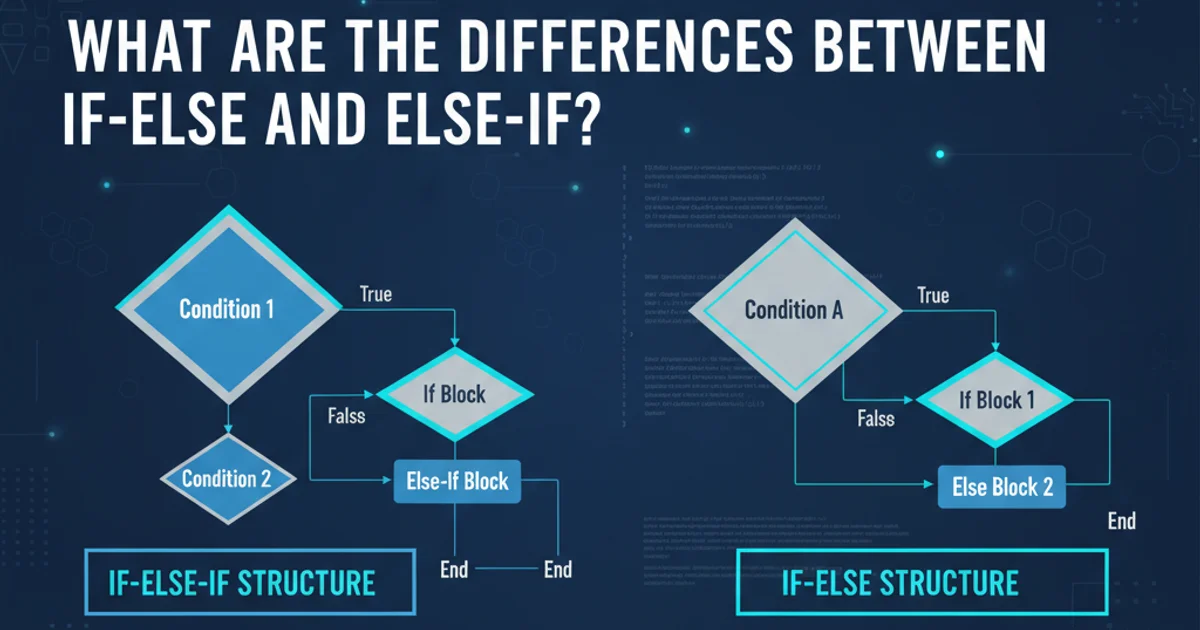What are the differences between if-else and else-if?
Categories:
If-Else vs. Else-If: Understanding Conditional Logic in Programming

Explore the fundamental differences between if-else and else-if constructs in programming, their use cases, and how they impact control flow and code readability.
Conditional statements are the backbone of decision-making in programming. They allow your code to execute different blocks of instructions based on whether certain conditions are met. Among the most common conditional constructs are if-else and else-if. While they both serve to control program flow, their structures and implications for logic and execution differ significantly. Understanding these differences is crucial for writing efficient, readable, and bug-free code.
The 'if-else' Construct: Binary Decisions
The if-else statement is used for binary decisions, meaning there are exactly two possible outcomes: either the condition is true, or it's false. If the if condition evaluates to true, the code block immediately following it is executed. Otherwise, if the condition is false, the code block associated with the else statement is executed. Only one of these two blocks will ever run.
int score = 75;
if (score >= 60) {
printf("You passed!\n");
} else {
printf("You failed.\n");
}
Basic if-else statement in C
flowchart TD
A[Start] --> B{score >= 60?}
B -->|Yes| C[Print "You passed!"]
B -->|No| D[Print "You failed."]
C --> E[End]
D --> E[End]Flowchart of an if-else decision
if-else when you have a clear two-way choice. It ensures that exactly one of the two code paths will be taken, making your logic explicit and preventing unintended fall-through.The 'else-if' Construct: Multiple Conditions
The else-if construct (often written as else if in many languages) is used when you need to check multiple, mutually exclusive conditions sequentially. It allows you to chain several conditions together. The program evaluates the if condition first. If it's false, it moves to the first else if condition. If that's also false, it moves to the next else if, and so on. As soon as a condition evaluates to true, its corresponding code block is executed, and the entire if-else if-else chain is exited. If none of the if or else if conditions are true, the final else block (if present) is executed as a default.
int temperature = 25;
if (temperature < 0) {
printf("Freezing!\n");
} else if (temperature >= 0 && temperature < 15) {
printf("Cold.\n");
} else if (temperature >= 15 && temperature < 25) {
printf("Mild.\n");
} else {
printf("Warm.\n");
}
Chained if-else if-else statement in C
flowchart TD
A[Start] --> B{temperature < 0?}
B -->|Yes| C[Print "Freezing!"]
B -->|No| D{temperature >= 0 && < 15?}
D -->|Yes| E[Print "Cold."]
D -->|No| F{temperature >= 15 && < 25?}
F -->|Yes| G[Print "Mild."]
F -->|No| H[Print "Warm."]
C --> I[End]
E --> I[End]
G --> I[End]
H --> I[End]Flowchart of an if-else if-else chain
else-if creates a single, sequential decision structure where only one block will execute. Multiple independent if statements, on the other hand, would evaluate each condition separately, potentially executing multiple blocks if their conditions are met.When to Choose Which
The choice between if-else and else-if depends entirely on your logical requirements:
Use
if-elsefor:- Simple true/false decisions.
- When you have two mutually exclusive outcomes.
- Ensuring that one of two paths is always taken.
Use
else-iffor:- Handling multiple, distinct conditions that are checked in a specific order.
- Creating a series of mutually exclusive conditions where only one block should execute.
- Implementing a decision tree where subsequent conditions are only checked if previous ones fail.
Consider the order of your else-if conditions carefully, as the first true condition will execute its block and prevent subsequent else-if conditions from being evaluated, even if they would also be true.
if statements when else if is more appropriate. This can lead to unexpected behavior where multiple code blocks execute when only one was intended, or to redundant checks that reduce performance.